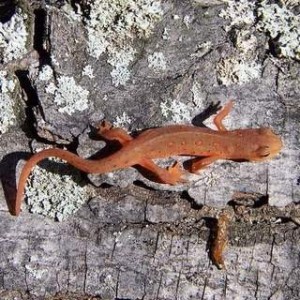Eastern Newt
Overview:
Scientific Name: Notophthalmus viridescens
Size: 2.5 – 5.5” (adult length)
Status: Can be locally abundant in good habitat but can suffer declines or extirpations when ponds are drained or polluted or when deforestation takes place surrounding breeding ponds.

Habitat:
Occupy small, permanent ponds with aquatic vegetation. Will also occur in temporary ponds, shallows of large lakes, and in river sloughs and backwaters. Terrestrial efts usually will be found under cover objects (such as bark or rotting logs) in wooded areas near breeding ponds.
Adult Coloration:
Aquatic adults are olive, greenish brown, or reddish brown from above, with small black spots over the back and tail. Depending on subspecies there may be a row of red spots along each side, sometimes with black border. Usually dark stripe though eye. Throat and belly yellow with tiny black dots.
Adult Characteristics:
Skin appears dull and is not slimy. In some populations, breeding adults retain external gills (this retention of larval characteristics is known as neoteny). Aquatic adult males develop high, rounded tail fins that extend to a point in front of the hindlegs during the breeding season. Females have straighter fins that extend to a point behind the hindlegs. Males also have thicker hindlegs than females, with rough black ridges on inner thighs and black nubs on the toes.
Juvenile Characteristics:
Juvenile Eastern Newts are known as efts, and are fully terrestrial. This is a unique life history among Michigan’s salamanders, where eggs hatch in an aquatic environment, larvae develop into terrestrial juveniles, and then these grow into aquatic breeding adults. Efts are usually red, orange, or reddish brown above with a light yellow belly. The skin is rough and bumpy. Tails round in cross section. Efts that are developing into aquatic adults may be darker and appear intermediate in body shape and color. Occasionally adults will transform into terrestrial forms to transfer breeding pools, but these are larger (efts range from 1.4 – 3.4” in length).
Larvae Characteristics:
Larvae are usually grayish or olive brown with black spots, have one or two rows of light yellow spots on each side, and black stripes running through the eyes. Head becomes narrower toward the nose, appearing wedge-shaped. Tail fins extend up the back.
Species Confused With:
Unlikely to be confused with other salamanders in the region due to its distinctive coloration, bumpy skin, and distinct terrestrial and aquatic forms
Distinction between subspecies:
Two subspecies are found in Michigan. Red-spotted Newts (N. viridescens viridescens) usually have two rows of black-bordered red or orange spots on the back, both as efts and adults. The Central Newt (N. viridescens louisianensis) is smaller, and red spots either lack black borders or are completely absent.
References:
- Amphibians and Reptiles of the Great Lakes Region by Jim Harding
- Harding, J.H. and J.A. Holman. 1992. Michigan Frogs, Toads, and Salamanders. MSU Cooperative Extension Service and MSU Museum. Extension Bull. E-2350, 144 pp.
- Ruthven, A. G., H. B. T. Gaige, et al. 1912. The herpetology of Michigan, by Alexander B. Ruthven. Crystal Thompson and Helen Thompson; Memoranda towards a bibliography of the archaeology of Michigan, by Harlan I. Smith; prepared under the direction of Alexander G. Ruthven. Lansing, Mich., Wynkoop Hallenbeck Crawford, State Printers.
- Holman, J. A. 2012. The Amphibians and Reptiles of Michigan: A Quaternary and Recent Faunal Adventure. Detroit, Mich., Wayne State University Press.
- Conant, R., and Collins, J. T. 1998. Reptiles and Amphibians: Eastern, Central North America. Houghton Mifflin Harcourt Press.
